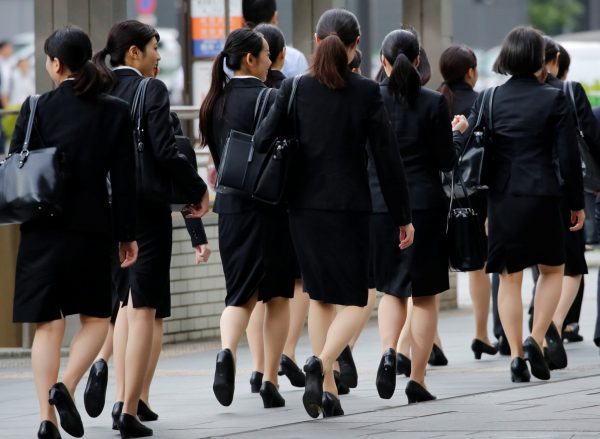International rankings such as those composed by the World Economic Forum consistently rank Japan as one of the most gender-unequal countries in the developed world. But there is little, if any, gender gap in health and education — Japan’s low rank stems from inequality in the realms of political and economic empowerment.
At first glance, Japan’s workforce gender gap seems to be shrinking. More women than ever participate in paid labour. The labour force participation rate of women aged 25–54 increased from 66.5 per cent in 2000 to 76.3 per cent in 2016, overtaking the United States. And the pay gap is shrinking, if slowly — Japanese women now earn on average 73.4 per cent of what men do.
Yet the Japanese workforce continues to be vertically and horizontally gender segregated. Women occupy female-dominated industries that are generally not as well-paid as male-dominated industries and they are clustered around the lower rungs of the career ladders in most industries.
This segregation is manufactured by discrimination. University medicine departments, for example, manipulate intake examination results to cap female enrolments at 20 per cent. Unsurprisingly, the percentage of women doctors in Japan has hovered at around 20 per cent for 15 years.
The ‘dual-track’ white-collar hiring system is another example of workforce gender segregation implemented at the recruitment stage. Introduced at the time of the 1986 Equal Employment Opportunity Law, and still in use in large companies, the system puts most female recruits into a ‘clerical track’ employment category. Male recruits are placed in ‘managerial track’ roles, facilitating the concentration of men in managerial positions.
Given the corporate demands made of those aspiring to management — including international or domestic transfers and lengthy overtime work — and the fact that housework and childrearing continues to be carried out overwhelmingly by women, it is perhaps not surprising that most women do not choose the managerial track. This behaviour exhibits what Kumiko Nemoto calls ‘depressed aspirations’.
Depressed aspirations, a response to harsh working conditions in many Japanese workplaces, also partially explain the disproportionate number of women found in ‘non-standard’ employment. More than half of all female workers are non-standard, compared to a figure of 38 per cent for all workers. Non-standard employment is a way for workers to escape the all-encompassing demands of full-time work, which generally require the sacrifice of family life, health and individual freedom.
Despite the working population in Japan shrinking since the 1980s, the number of jobs has increased by about 15 million. But almost of all these jobs are non-standard and it is mostly women and older people who fill them. From 1982 to 2012, the number of women employees rose from 14.5 to 24 million, with over 90 per cent of the jobs they took up being non-standard.
While female workforce participation rates have improved, the quality of jobs is declining for the working female population overall. 71.3 per cent of female high school graduates born between 1963 and 1967 became standard workers 20 years later, but this figure has been dropping rapidly. Only 48.4 per cent of women born in 1988–89 entered full-time work this century.
This expansion of non-standard work at the expense of standard work has limited the opportunities available for women to become financially independent and contributes to the ongoing economic disempowerment of women.
Labour market deregulation permitted the growth of job categories with subsistence-level wages and conditions, but it has a strong negative impact on women’s economic empowerment. This deregulation, along with other neoliberal policies rolled out by successive LDP–Komeito governments since the Koizumi administration and expanded under Abe, established conditions for the emergence of a large ‘working poor’ population in Japan. Gender inequality is growing as poverty deepens.
The figures on rising poverty in Japan, especially among young women, provide a disturbing contrast to the rhetoric of the Abe government’s ‘womenomics’, a set of policies that target elite career women with the aim of boosting the economy. According to a 2014 report by Japan’s national broadcaster NHK, one third of women of working age are in poverty, defined as those earning 1.14 million yen (US$10,500) a year or less. Conditions are worsening even further for women in their teens and twenties. The situation is compounded for young single mothers — statistics show 80 per cent of single mothers in Japan in their twenties are in poverty.
For Japanese women, gendered labour market discrimination fuels their second-class civil status. It leaves them hoping for marriage as a trade, vulnerable to commercial sexual exploitation and bereft of opportunities in leadership and decision-making. Japan continues to slide further into malady as the sick man of Asia, and it does so obstinately while retaining a female population that is highly educated, hard-working and acutely aware of what it takes to succeed from behind.
Dr Emma Dalton is a lecturer in the School of Global, Urban and Social Studies at the Royal Melbourne Institute of Technology (RMIT).
Dr Caroline Norma is a lecturer in the School of Global, Urban and Social Studies at the Royal Melbourne Institute of Technology (RMIT).


Thanks for an excellent summary of the situation for women in Japan.
Perhaps it was a lack of space but one thing was left out in this analysis. Some pundits have noted that many Japanese women marry later, if at all, because of these economic and social dynamics. Some also have opined that the decline in birth rate is partially due to the economic and social inequality which women in Japan have to live with. Ie, many have given up on marriage and/or family because of a sense of pessimism, if not hopelessness, over their prospects for the future.